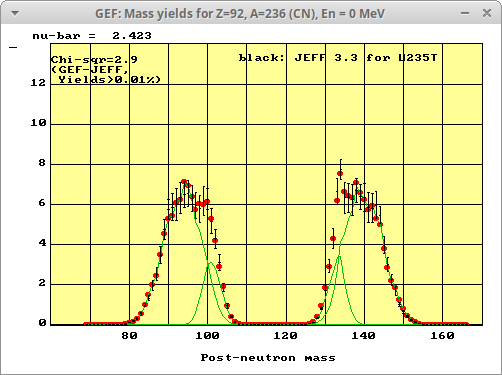GEF 2021/1.1
General
description of fission observables.
Last update May 23, 2022. (Pre-saddle mass loss added to list-mode output.)
Short characterisation of
GEF 2021/1.1:
Compared to GEF 2020/1.2 there are two major modifications:
1. The description of the mass yields in the pre-actinides, especially
asymmetric fission of nuclei around mercury, lead has been made more
consistent with a unique parameter set, without using locally adjusted
parameters.
2. A modified concept has been introduced to construct a new composite
formula of the nuclear level density.
a) The low-energy part is still described by the
empirical constant-temperature systematics of von Egidy and Bucuresu.
This is a very solid empirical information.
b) The high-energy part is still described by the
Fermi-gas formula of independent Fermions, based on a fictive
macroscopic ground state. This is a rather well established theoretical
expectation. However, an exponentially decreasing influence, originally
introduced by Ignatuyk et al. to reflect the influence of shell
effects, is interpreted to represent the E* depencence of the
collective enhancement, in addition. (The same E* dependence for both
contributions is assumed, since the E* dependence of the collective
enhancement is not well known.) The magnitude of this exponentially
decreasing contribution is adjusted by the condition that the level
densities of the low-energy part and the high-energy part match at the
transition energy. This way, the transition energy is not determined
any more by the technical matching condition, as in the Gilbert-Cameron
composite formula, but it can be adjusted to the critical nuclear
pairing energy from theoretical models or, eventually from other
experimental observables. Moreover, there is room for the influence of
collective enhancement, which is not taken into account in the
Gilbert-Cameron matching condition, even if the shell effect is
considered. (A more detailed discussion is in preparation.)
The mass distribution of 235U(nth,f) from GEF-2019/1.1
(red
points) in
comparison with the JEFF 3.3 evalution (black symbols with error
bars). The calculated contributions from different
fission channels are traced in green. 10 million events have been
calculated.
An extended version of GEF-2021/1.1 that
includes delayed processes (output of delayed-neutron multiplicities,
delayed-neutron emitters, cumulative fission-fragment yields in ENDF
format) is available on demand. It provides
also an
option for producing random files of fission-fragment yields in ENDF
format.
We
are happy about any feed-back (mail to
schmidt-erzhausen<at>t_online.de). This helps to correct
errors,
to improve the quality of the model and to better respond to the needs
and preferences of the users.
Use of the GEF code is subject to the GNU GENERAL PUBLIC LICENSE
agreement that you find here: <License>.
Stand-alone version (Monte-Carlo method)
The
stand-alone version of the GEF code is written in FreeBASIC (a). The
FreeBASIC compiler produces binary code from the same source on Windows
(b) and on Linux. The executable uses the C library.
For
the Windows
version, a GUI is provided, written in JustBasic (c). The Windows
version runs also on Linux with Wine (d). The Windows version
runs also on OS X (e)
with Wine (d).
a) FreeBASIC is available from http://www.freebasic.net/
with no
cost.
b) Windows is either a registered trademark or a trademark of Microsoft
Corporation in the United States and/or other countries.
c) JustBasic is available from http://www.justbasic.com/ with no cost.
d) Wine is a windows compatibility layer for Linux and Mac OS X
(http://www.winehq.org/).
e) OS X is a trademark of Apple Inc., registered in the U.S. and other
countries.
Quick start on Windows:
- Download the binaries
(that includes some additional files).
- Start GEF.bat
in a
command window.
- Fill in the input mask of the graphical user interface and
start
the calculation.
- Output is written to file \out\...
.dat.
Quick start on Linux:
- Download the binaries, 32 bit version.
- Download the binaries, 64 bit version.
- Make sure that the binary file GEF is executable.
- Enter ./GEF
in a command
window.
- Answer the input dialogue.
- Output is written to file
/out/... .dat.
Windows version
Input mask
of the graphical
user interface:
For Windows and Linux
Complete
package
Documentation
Readme
file
(Technical information, list of relevant publications)
JEFF-Report
24, part I
(Comprehensive documentation of the GEF model.)
JEFF-Report
24, part II
(Technical information on the GEF code.)
Source (for Windows and Linux)
Source
files
Data
Input files for extended input options
Distribution of entrance energies (example)
List of input parameters (example)
See Readme
file
for more detailed information.
Output
Data tables in XML-assisted format (example)
List-mode file (example)
(short sample of most complete event list)
Raw data for the multi-variate distribution of fission-fragment yields
from calculations with perturbed parameters (example)
See Readme
file
for more detailed information.
You
may consider using the Windows version of GEF on Linux with Wine in
order to profit from the more comfortable input handling offered by the
graphical user interface. This option may also solve problems of
missing libraries under Linux.
Subroutine (Folding method)
The subroutine aims for being used
in combination with other nuclear-reaction codes. For a given
fissioning nucleus with excitation energy E* and angular
momentum I
it calculates complete distributions of a number of fission observables
before emission of prompt neutrons and prompt gamma radiation with the
GEF model.
Documentation
Technical description of the subroutine
FreeBASIC version
Source files (Released Dec. 3, 2021)
FORTRAN version
Source files (Released Dec. 3, 2021.) Please inform us, when you encounter problems!


